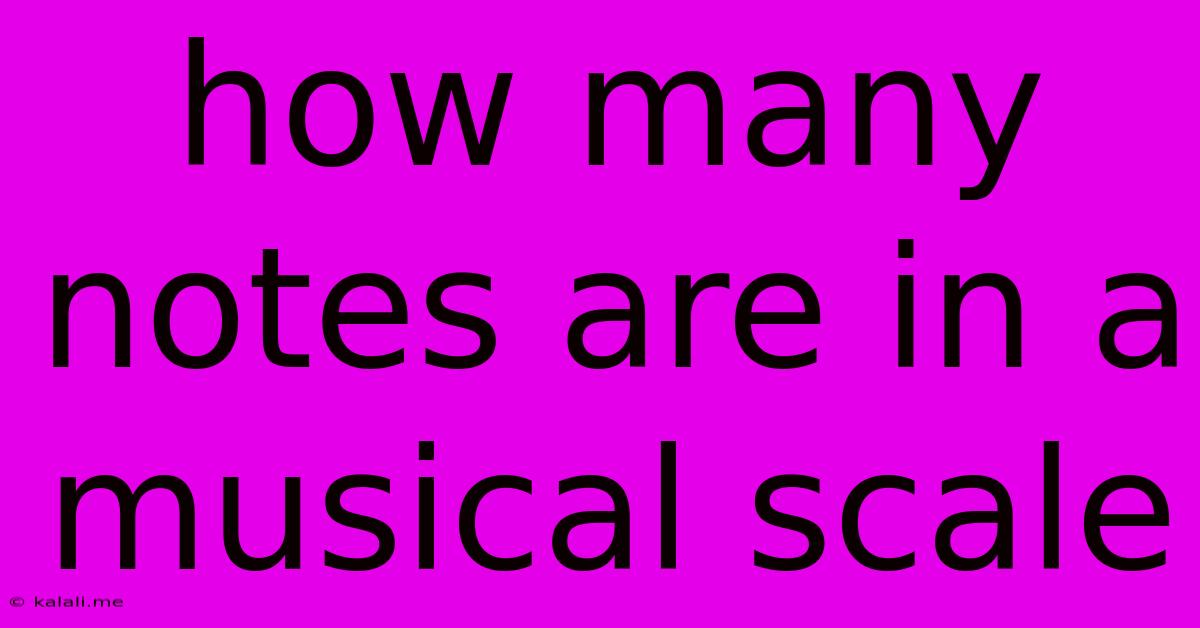How Many Notes Are In A Musical Scale
Kalali
May 20, 2025 · 3 min read

Table of Contents
How Many Notes Are in a Musical Scale? A Beginner's Guide
Understanding the number of notes in a musical scale is fundamental to music theory. While the answer seems straightforward, it depends on several factors, including the type of scale and the octave range considered. This beginner's guide will break down the complexities and provide a clear explanation. This article will cover diatonic scales, pentatonic scales, and chromatic scales, explaining the note counts for each.
The Diatonic Scale: The Foundation of Western Music
The most common type of scale in Western music is the diatonic scale. This scale, which forms the basis for many musical genres, typically contains seven notes. These seven notes are arranged in a specific pattern of whole and half steps (intervals between notes). The exact pattern depends on the specific diatonic scale (e.g., major, minor, harmonic minor, melodic minor). These variations within the diatonic scale still generally maintain the seven-note structure. Think of popular songs, many use a major or minor diatonic scale which contains 7 notes.
Examples of diatonic scales include:
- Major scale: A happy-sounding scale with a characteristic "do-re-mi" pattern.
- Natural minor scale: A slightly sadder-sounding scale, the relative minor of the major scale.
- Harmonic minor scale: A minor scale with a raised 7th degree, adding a characteristic "lift" or tension.
- Melodic minor scale: A minor scale with a raised 6th and 7th degree when ascending, returning to the natural minor notes when descending.
Pentatonic Scales: Five-Note Simplicity
Pentatonic scales are another common type of scale, containing only five notes. These scales are incredibly versatile and often found in folk music and blues. The simplicity of the pentatonic scale makes it easy to improvise and create melodic lines. These scales are often easier to learn for beginner musicians because of the reduced number of notes. Pentatonic scales frequently appear in many musical styles, including jazz and rock.
Chromatic Scale: All the Notes
The chromatic scale is a different beast altogether. It contains twelve notes, encompassing all the notes within an octave. This scale includes all the half steps and is used for modulating between keys or creating dramatic effects. The chromatic scale is essentially a collection of all the notes available, spanning a full octave. Understanding the chromatic scale helps with advanced music theory concepts, such as understanding chords and intervals.
Octaves and Note Repetition
It's crucial to remember that the number of notes in a scale can be affected by the octave range considered. An octave is the interval between two notes with the same name, but different pitches – for example, C to C. Each octave repeats the same seven notes (in a diatonic scale) or five notes (in a pentatonic scale), though at a different pitch. Thus, you may have 7 notes in one octave, 14 notes spanning two octaves, and so on. This concept extends to all the scales described here.
Conclusion: Context Matters
The simple answer is that a musical scale can have five, seven, or twelve notes depending on the type of scale being used. Understanding the distinction between diatonic, pentatonic, and chromatic scales is essential for anyone wanting a deeper understanding of music theory. By grasping these fundamentals, you will significantly improve your musical understanding and ability to compose or improvise. Remember that the context of the octave range also affects the total number of notes played.
Latest Posts
Latest Posts
-
What Are Try Squares Used For
May 20, 2025
-
Can You Cook Frozen Ground Meat
May 20, 2025
-
How Heavy Is 1 Liter Of Water
May 20, 2025
-
How To Stop A Cockerel Crowing
May 20, 2025
-
Looking Forward To Speaking With You
May 20, 2025
Related Post
Thank you for visiting our website which covers about How Many Notes Are In A Musical Scale . We hope the information provided has been useful to you. Feel free to contact us if you have any questions or need further assistance. See you next time and don't miss to bookmark.